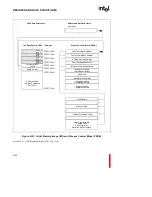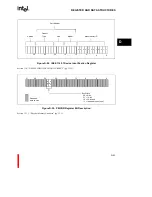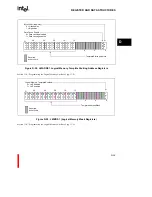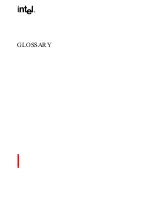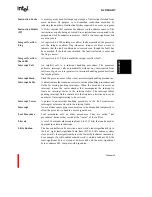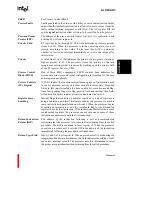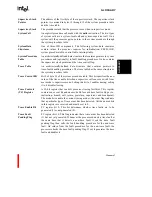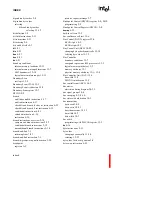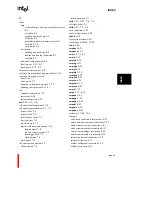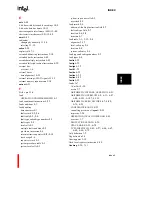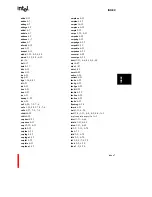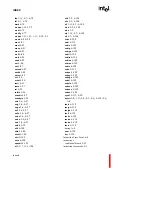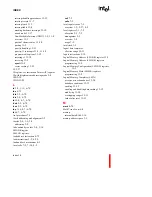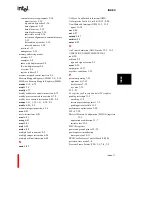
GLOSSARY
Glossary-6
RIP
See Return Instruction Pointer.
Software Reset
Re-running of the Reset microcode without physically asserting the
RESET# pin or removing power from the CPU.
SP
See Stack Pointer.
Special Function
Registers (SFRs)
A 32-bit register (sf0-sf4) used to control specific sections of the
processor. These registers can be manipulated like any other register, but
their contents affect the processor’s behavior directly.
Stack Frame
A block of bytes on a stack used to store local variables for a specific
procedure. Another term for a stack frame is an activation record. Each
procedure that the processor calls has its own stack frame associated with
it. A stack frame is always aligned on a 64-byte boundary. The first 64
bytes in a stack frame are reserved for storage of the local registers
associated with the procedure. The frame pointer (FP) and stack pointer
(SP) for a particular frame indicate location and boundaries of a stack
frame within a stack.
Stack Pointer (SP)
The address of the last byte in the current (topmost) frame of the
procedure stack. The SP is contained in local register r1.
Stack
A contiguous array of bytes in the address space that grows from low
addresses to high addresses. It consists of contiguous frames, one frame
for each active procedure. i960 architecture defines three stacks: local,
supervisor and interrupt.
State Flag
PC register bit 10. This flag indicates to software that the processor is
currently executing a program (0) or servicing an interrupt (1).
State
The type of task that the processor is currently working on: a program or
an interrupt handling procedure. The processor sets the PC register state
flag to indicate its current state.
Status and Control
Registers
A set of four 32-bit registers that contain status and control information
used in controlling program flow. These registers include the instruction
pointer (IP), AC register, PC register and TC register.
Supervisor Call
A system call (made with the
calls
instruction) where the entry type of
the called procedure is 102. If the processor is in user mode when a
supervisor call is made, it switches to the supervisor stack and to
supervisor mode.
Supervisor Mode
One of two execution modes – user and supervisor – that the processor
can use. The processor uses the supervisor stack when in supervisor
mode. Also, while in supervisor mode, software is allowed to execute
supervisor mode instructions such as
sysctl
and
modpc
.
Summary of Contents for i960 Jx
Page 1: ...Release Date December 1997 Order Number 272483 002 i960 Jx Microprocessor Developer s Manual ...
Page 24: ......
Page 25: ...1 INTRODUCTION ...
Page 26: ......
Page 35: ...2 DATA TYPES AND MEMORY ADDRESSING MODES ...
Page 36: ......
Page 46: ......
Page 47: ...3 PROGRAMMING ENVIRONMENT ...
Page 48: ......
Page 73: ...4 CACHE AND ON CHIP DATA RAM ...
Page 74: ......
Page 85: ...5 INSTRUCTION SET OVERVIEW ...
Page 86: ......
Page 111: ...6 INSTRUCTION SET REFERENCE ...
Page 112: ......
Page 233: ...7 PROCEDURE CALLS ...
Page 234: ......
Page 256: ......
Page 257: ...8 FAULTS ...
Page 258: ......
Page 291: ...9 TRACING AND DEBUGGING ...
Page 292: ......
Page 309: ...10 TIMERS ...
Page 310: ......
Page 324: ......
Page 325: ...11 INTERRUPTS ...
Page 326: ......
Page 369: ...12 INITIALIZATION AND SYSTEM REQUIREMENTS ...
Page 370: ......
Page 412: ......
Page 413: ...13 MEMORY CONFIGURATION ...
Page 414: ......
Page 429: ...14 EXTERNAL BUS ...
Page 430: ......
Page 468: ......
Page 469: ...15 TEST FEATURES ...
Page 470: ......
Page 493: ...A CONSIDERATIONS FOR WRITING PORTABLE CODE ...
Page 494: ......
Page 502: ......
Page 503: ...B OPCODES AND EXECUTION TIMES ...
Page 504: ......
Page 515: ...C MACHINE LEVEL INSTRUCTION FORMATS ...
Page 516: ......
Page 523: ...D REGISTER AND DATA STRUCTURES ...
Page 524: ......
Page 550: ......
Page 551: ...GLOSSARY ...
Page 552: ......
Page 561: ...INDEX ...
Page 562: ......
Page 578: ......

